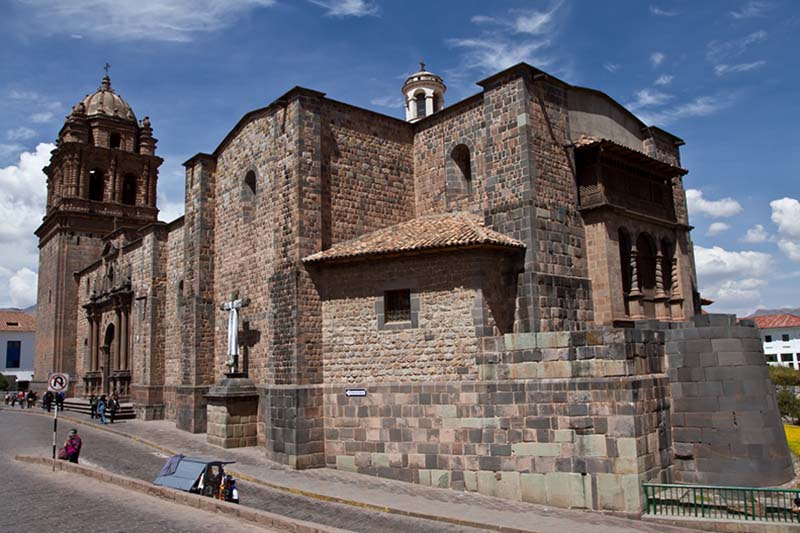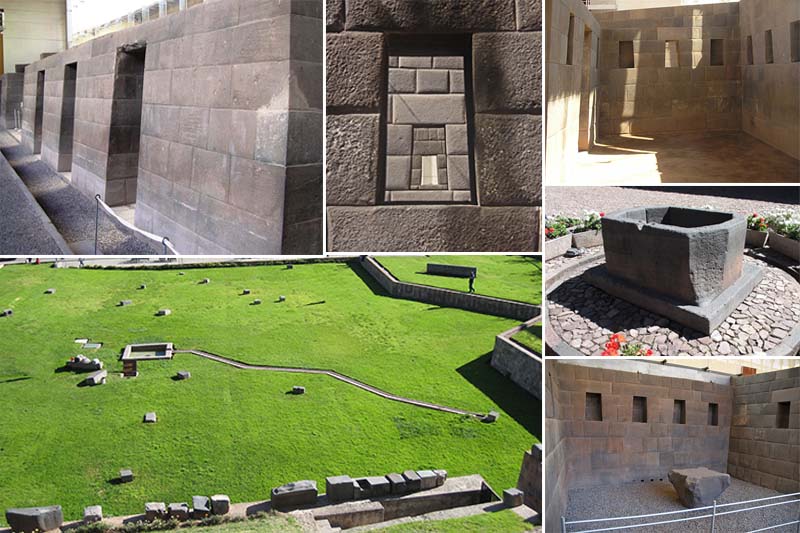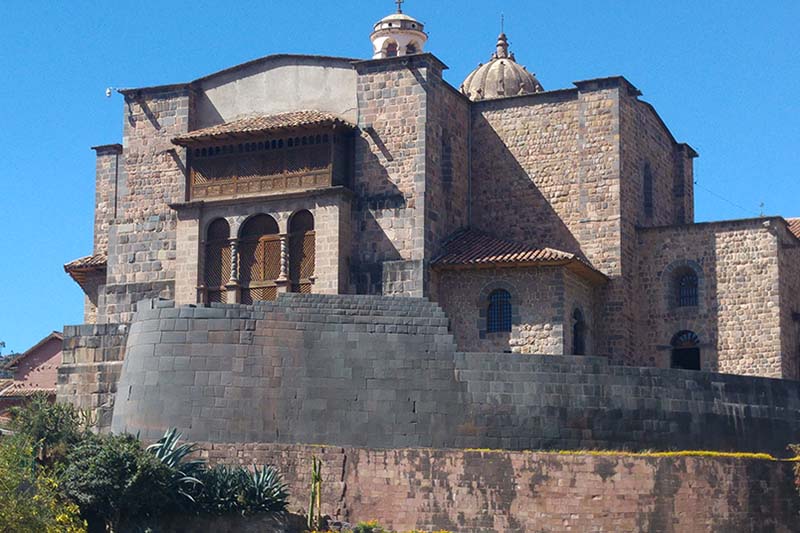Coricancha: Inca temple, museum and convent of Santo Domingo
Possibly the most sacred and important building in the Tahuantinsuyo empire was the Coricancha, also known as the Temple of the Sun. During the time of the conquest, the temple was destroyed and looted. On its base, the church and convent of Santo Domingo were built. Currently, there is a museum with all the Inca pieces that were found there during the excavations.
- Coricancha: archaeological site
- Coricancha: site museum
- Coricancha: Convent of Santo Domingo
- Coricancha image gallery
- Questions and answers about the Coricancha
The Coricancha temple is located at the intersection of El Sol Avenue and Santo Domingo Street, two blocks from the Plaza de Armas of Cusco in Peru. It can be visited from Monday to Saturday from 8 am to 5 pm You can buy the entrance ticket in the same place.
Coricancha: archaeological site
This temple was built during the government of the Inca Huiracocha in the 13th century, approximately. Emperor Pachacutec, the builder of Machu Picchu, was the one who embellished it in the 15th century. The thin walls of the temple express the highest level of engineering that the Incas achieved. Its walls fit perfectly without any mortar. Much of the walls as well as doors and temples are known to have been covered by a broad band of gold. After the Spanish invasion, the temple was looted and the gold stolen.

Santo Domingo Church and Convent – Coricancha
Enclosure of the Sun
- In this room was a representation of the god Huiracocha and some Inca mummies. The enclosure was protected by mamaconas or priestesses from the sun. This temple does not present any material in the joints of the stone blocks that form its walls and there is no space between the blocks, as if they could have shaped the stones as they pleased.
Enclosure of the Stars
- In this temple the stars, servants of the moon, daughters of the sun and the moon were worshiped. The Incas believed that the stars were placed in the sky in correspondence with all the animals on earth. In the middle part of the Temple of the Stars you can see a ceremonial niche where you can see works done in low relief and bone remains of auquénidos. This niche is directly related to the sunrise during the winter solstice.
Rainbow Enclosure
- This temple is called the rainbow enclosure, as it was thought that it came from the sun. All the walls of the enclosure must have been completely covered in gold. According to the chroniclers, on a plate on the wall was the arch of heaven painted in its seven colors.
Sacrificial Enclosure
- Adjacent to the rainbow enclosure there is a large space whose specific function has not yet been deciphered. In the middle of this enclosure there is a lithic element in the form of a table, brought from the sacred garden. That is why this room is known as a place of sacrifice. At the bottom of the wall there are three well-carved holes that served as drainage.
Ceremonial fountain
- It is a fountain from the colonial era worked by hand that fulfilled the function of an octagonal water tank and a square base. Some chroniclers affirm that it is of Inca origin and that chicha was poured into it, as an offering to the sun god (god Inti).

Coricancha Enclosures
Lightning Enclosure
- This enclosure is also known as the temple of thunder or lightning. It is the last of the enclosures whose access has three doors. As its name indicates, it was destined for the cult of lightning (the Incas named it with the Quechua word ‘Illapa’ ). The worship of this god consisted of animal offerings and even, in times of drought, with human sacrifices of boys and girls (Capacocha ceremony).
Sacred Alley
- This famous passage led to the most important enclosure in the Coricancha where the god Inti (sun) was worshiped. It consists of two enormous stone walls built with perfectly carved blocks. Among these, a rock with more than twenty-four angles stands out. The alley is approximately 10 meters long. It is one of the most photographed venues by visitors.
Sacred Gardens
- The gardens were decorated with the various species of Andean flora as well as multiple gold and silver works. You can still see one of the sources of the ancient sacred garden. During the festivities of the sun, the peoples conquered by the Incas made a pilgrimage to the city of Cusco, bringing different offerings that were stored in these gardens.
Coricancha: site museum
After the excavation work carried out at the Coricancha archaeological site, the site museum was created with the objects found during the works. The museum consists of five rooms with different ceramic pieces, tools and even bone remains. The museum also exhibits information panels that explain the Inca lifestyle from its beginnings to its conquest.
Where is?
- The museum is located under the esplanade of the Coricancha archaeological site. It can be reached on foot from the Plaza de Armas in Cusco by following El Sol Avenue for a few blocks.
- Its exact address is: avenida El Sol 526, Cusco.
How much is admission?
- The entrance to the Coricancha site museum is included in the Tourist Ticket of Cusco. The cost of this ticket is 70 Peruvian soles (22 US dollars) and also includes access to: Regional Historical Museum, Museum of Contemporary Art, Monument to Pachacutec, Museum of Popular Art, Qosqo Center for Native Art, Tipon Archaeological Park and Piquillacta Archaeological Park.
What is the attention hour?
- The museum is open Monday to Sunday from 9 a.m. to 6 p.m. The maximum residence time is 1 hour. It also offers access to the esplanade of green areas of the Coricancha.
What objects does it exhibit?
- Ceramic pieces.
- Ceremonial vessels (keros).
- Stone tools for war.
- Seashell decorations.
- Royal mummies of the Incas.
- Inca textile mantles.
- Skulls
- Wooden tools for domestic use.
- Knitted alpaca wool ponchos.
Coricancha: Convent of Santo Domingo

Temple of the Sun – Qoricancha
Location
- The Santo Domingo Convent is located next to the entrance door to the Coricancha Temple. It can be reached on foot from the Plaza de Armas in Cusco.
- The exact address is: calle Ahuacpinta 659-A, Cusco.
- It remains open every day of the year from 6 in the morning until 8 at night.
History
- After the looting of the Coricancha temple by the Spanish in the 16th century, as happened with all the Inca temples, a religious order was commissioned to build a Catholic religious temple to replace the Inca gods with those of the West.
- It was Juan Pizarro (brother of Francisco Pizarro) who gave the Coricancha to the Dominican congregation in 1534. They built the church on the ruins of the Inca site. The construction of the religious temple took approximately one hundred years.
- The church of Santo Domingo del Cusco suffered severe damage after the earthquake of 1650. The same happened with the earthquake of 1950. The reconstructions took several years to take their current form in 3 naves with a dome and various decorations of wood, gold and silver.
- Despite all the earthquakes, the Inca site of Coricancha suffered no damage.
What to see
- The baroque architecture of the exterior of the temple.
- Canvases of the walls made by the ‘Cusco school’. They emphasize ‘The life of San Vicente Ferrer’ and ‘The life of Santo Domingo de Guzmán’.
- The Baroque Pulpit.
- The stone church tower, a masterpiece of colonial stonework.
How to go?
- Entrance to the Santo Domingo church is free during the mass hours that are: in the morning (7 am) and at night (7 pm).
- Outside of mass hours, an entrance ticket must be paid at the same door. The approximate cost is 15 Peruvian soles (5 US dollars).
- At the entrance gate there are tourist guides that offer a tour of the temple explaining every detail of the architecture, canvases and more.
Coricancha image gallery
Questions and answers about the Coricancha
1) Is the Coricancha the most important temple of the Incas?
Yes, the Coricancha was the most important and imposing religious temple of the entire Tahuantinsuyo (the empire of the Incas). It was even more important than Machu Picchu.
2) Who built the Coricancha?
Research indicates that the Coricancha was built in the government of the Inca Huiracocha (13th century). However, the emperor Pachacutec was the one who embellished it in the fifteenth century and ordered the construction of its main shrines.
3) What was the function of the Coricancha?
The Coricancha was an Inca religious temple of great importance. There they worshiped gods like the earth, the mountains, the stars, the moon. However, the main Inca divinity was the sun (Inti).
4) Where is the Coricancha temple located?
This Inca temple is located in the city of Cusco, just 600 meters from the Plaza de Armas.
5) Was the Coricancha full of gold?
The chronicles indicate that some temples of the Coricancha (such as the temple of worship to the sun) were adorned with gold sheets. In addition there were pieces of gold, silver and precious stones. These treasures were looted by the Spanish in the 16th century.
6) Did the Incas celebrate Inti Raymi at the Coricancha?
Yes, the chronicles indicate that the Incas celebrated the festival in honor of the sun, the Inti Raymi, on the esplanade of the Coricancha. This celebration is still carried out by the people of Cusco in honor of their ancestors. It is celebrated every year on June 24.
7) How much does the entrance to Coricancha cost?
The entrance to the Coricancha has a cost of 15 Peruvian soles, approximately 4 American dollars. It can be purchased at the door of the archaeological site.
8) What are the visiting hours of the Coricancha?
The Qoricancha archaeological site is open to tourists from Monday to Saturday from 8:30 am to 5:30 pm.
9) Where to hire a tour guide to visit the Coricancha?
At the door of the archaeological site of Coricancha you can hire the shared tour guide service (service with other tourists) or private (service only for a couple, family, friends, etc.).
10) Can I visit the Coricancha with a tour?
Yes, the Coricancha can also be visited with an all-inclusive tour. The City Tour Cusco includes a visit to: Cusco Cathedral, Sacsayhuaman, Qenqo, Pucapucara, Tambomachay and, of course, the Coricancha. It offers transportation, guide and tickets.
Advice from people who have been there
 By: Lucas P
By: Lucas P“You can not miss it“
“It is a fascinating place, you can appreciate the mixture of Inca and Spanish architectures. Then the convent of Santo Domingo was built on what was the most important place in the entire Inca empire and you can still see walls and some structures. If you are interested in history you can not miss this place.“
By Ticket Machu Picchu – Last updated, June 8, 2022